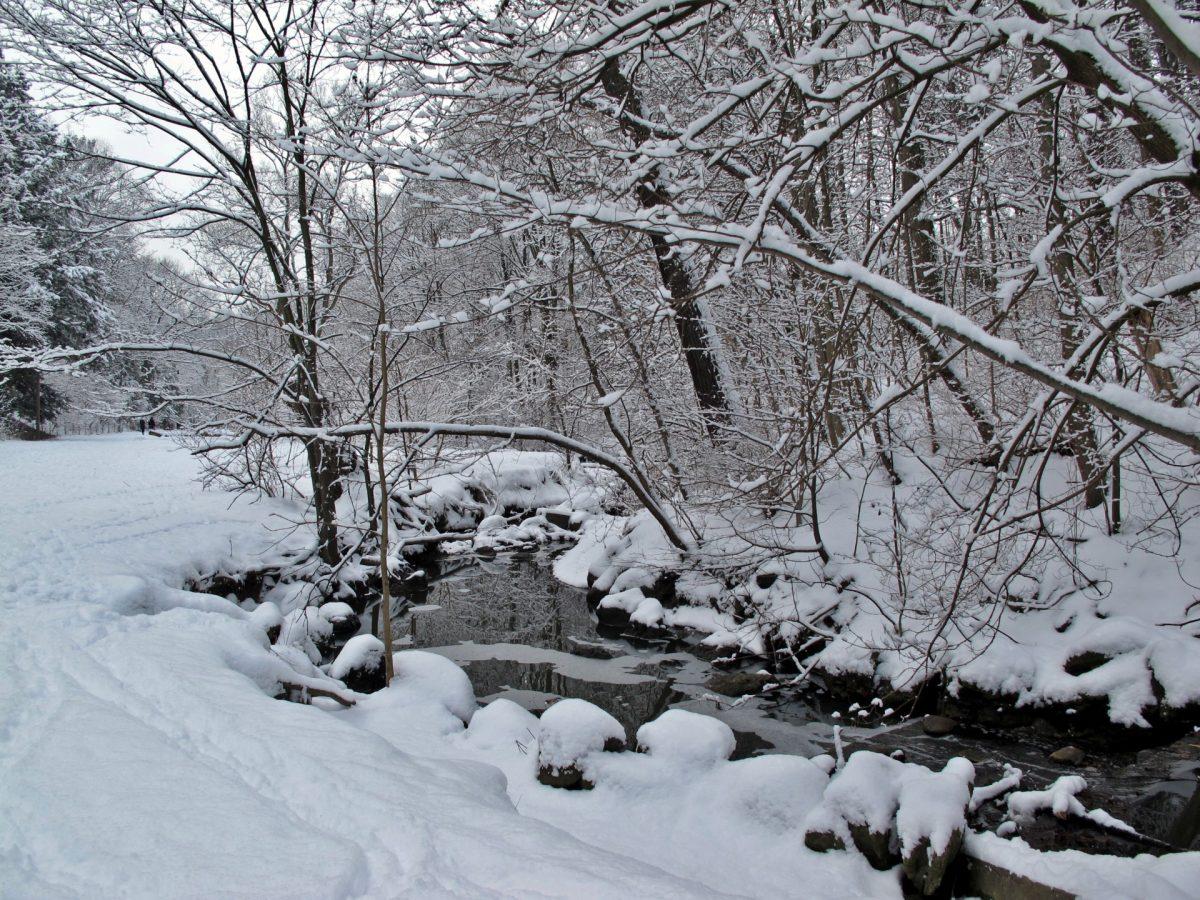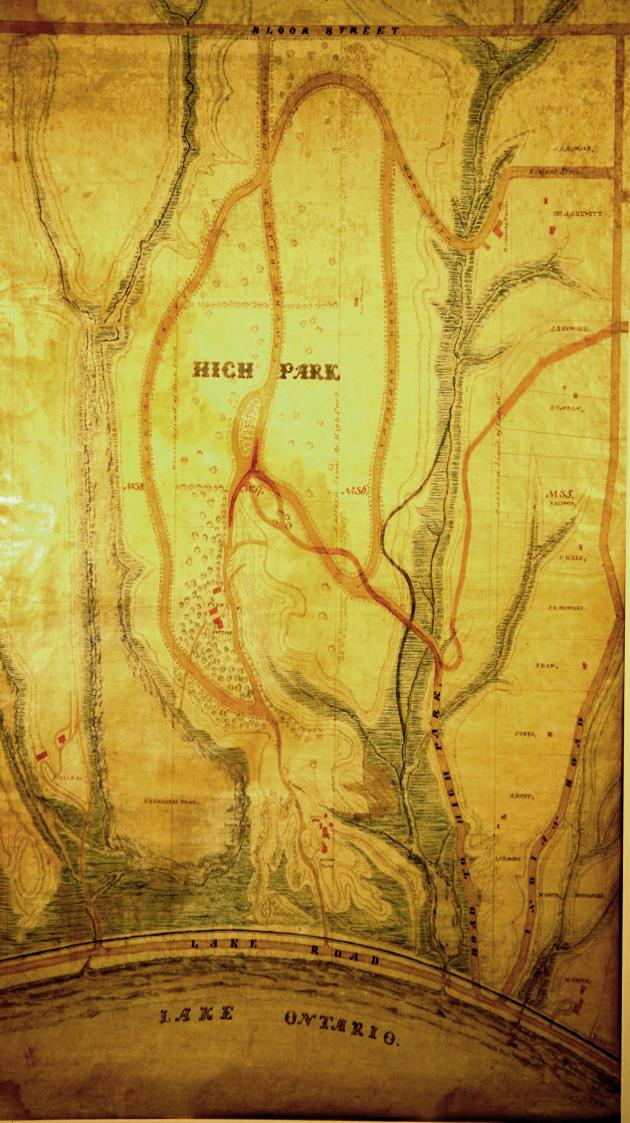by Ron Allan
Historical Course
Where does Spring Creek originate? The historical course of Spring Creek, which now flows south beside Spring Road on the eastern side of High Park, lies buried beneath the neighbourhood north of the Park. Although upper Spring Creek and its side-streams were all enclosed in the storm-sewer system in the late 1800s, their course can easily be followed from the shape of the local streets and the contours of the land.
Although it is not identified as such, the creek’s course is clearly marked on early maps of the area, rising west of Keele Street and north of Bloor Street, near the intersection of present-day Annette and Medland Streets. It flowed generally south, being joined by another branch flowing through today’s Baird Park. The main stream continued past Glenlake Avenue, then crossed Keele Street to continue down along the east side of Keele. Here it was joined by several small tributaries flowing from the east.
The creek flowed across Bloor Street through a low-lying swampy area (the Bloor-Keele intersection is still a saucer-shaped-depression) and turned westwards into the original Ridout property near what is now the northeast corner of High Park. It then flowed southwards towards Lake Ontario. Several tributaries joined it along the way, both from the west and from the east. The course of these side-streams can be clearly seen in the Park along Deer Pen Road, at Howard Park Avenue and through the present Adventure Playground in the Park.
The creek ended in a marshy area at the original lakeshore (The Queensway today), and from here it drained to the lake. A remnant of this widespread wet area is the Lower Duck Pond at the southeast corner of the Park.
Managing Stormwater and Sedimentation
Over the years, the course of Spring Creek within High Park has been rerouted to free up more picnic area. The lakefront has also been considerably extended. The creek still, however, empties into Lake Ontario. The majority of its volume flow today is stormwater from a 250-hectare catchment area north and northeast of the Park. (A smaller catchment area feeds Wendigo Creek on the west side of the Park, flowing from there to Grenadier Pond and Lake Ontario.)
To remove some of the debris (dirt, leaves, paper, plastic and other waste) picked up from roofs, driveways and streets in the catchment area, two sedimentation ponds were created in the 1950s at the point south of Bloor Street where Spring Creek flowed from a culvert into the Park. These ponds allowed settling out of some of the undesirable material in the water. (The Lower Duck Pond itself is a natural sedimentation pond.) In addition, a number of weirs were placed along the stream to reduce flow velocity and control erosion.
By the 1990s, however, it was recognized that the upper sedimentation ponds (now known as Howard and Ridout Ponds) were undersized and inefficient. They have since been expanded, including an added oil/grease trap, to about double their size with a corresponding increase in settling efficiency. They do nothing, of course, to reduce e.coli from animal waste, dissolved phosphorus and metals and the salt in winter time, all of which are carried directly down the creek to the lake.
Spring Creek's Old Eastern Tributaries
by Karyn Klaire Koski
The 1878 York County Atlas and late 1880s municipal maps both show creeks entering High Park from the east by crossing Parkside Drive. High Park’s founder, John Howard, also shows these creeks on his 1870s Plan of Survey.
One creek ran near the intersection of today’s Indian Grove and Indian Valley Crescent, at the base of a steep ravine hill. Howard’s Survey shows that this one had an additional finger, extending it further east to Indian Road. Somewhere between Indian Road and Indian Grove a spring existed and served as the headwater of this creek that eventually flowed into High Park.
The City of York (former Toronto) 1884 Goad Atlas shows the curve of this stream reaching just east of Parkside Drive and then curving back southeast towards the present-day intersection of Howard Park Avenue and Indian Road. By 1890 this creek is no longer shown.
Another set of short, spring-fed creeks are noted in both the 1884 Goad Atlas and Howard's Plan. They had entered south of Howard Park Avenue into High Park near where the “Jamie Bell Adventure Playground” is now located.
All these creeks were infilled or buried to make way for residential developments. Their names are largely lost, although the creek that ran along Indian Valley Crescent and Indian Grove was once referred to as the Indian Valley Creek by Professor of Geology, Elwood S. Moore. This particular creek entered into High Park at the exact location along Parkside Drive where sinkholes appeared in 2009. This stream is no longer shown outside the Park on current maps.
Sources
- Urban Underground Infrastructures, Michael Cook.
See also
- Natural History of Toronto's High Park
- Wendigo Creek and Wendigo Pond in High Park
- Laurentian River
- Geology of High Park
- High Park Underground
- Stormwater Ponds in High Park
- Lost Rivers article by Frank Remiz, first appeared in the West Toronto Junction Historical Society's newsletter, The Leader and Recorder, Spring 2012.





















